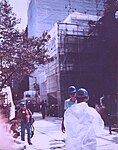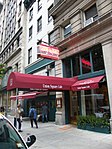18 Gramercy Park
AC with 0 elementsCondominiums and housing cooperatives in ManhattanGramercy ParkResidential buildings completed in 1927The Salvation Army

18 Gramercy Park is a 19-story historic building in Manhattan, New York City, USA. Built as a hotel in 1927 and designed by the architectural firm Murgatroyd & Ogden, it was a women's temporary residence owned by The Salvation Army from 1963 to 2008. It was then known as the Parkside Evangeline. In 2010, The Salvation Army sold the building to Eastgate Realty for US$60 million. The investors were the Zeckendorf family and Israeli billionaire Eyal Ofer. In 2012, the building was redesigned by Robert A.M. Stern Architects as a luxury 16-unit condominium building.Residents have a key to Gramercy Park, a private park.
Excerpt from the Wikipedia article 18 Gramercy Park (License: CC BY-SA 3.0, Authors, Images).18 Gramercy Park
Gramercy Park South, New York Manhattan
Geographical coordinates (GPS) Address Nearby Places Show on map
Geographical coordinates (GPS)
| Latitude | Longitude |
|---|---|
| N 40.737654 ° | E -73.986347 ° |
Address
Gramercy Park South 18
10003 New York, Manhattan
New York, United States
Open on Google Maps










